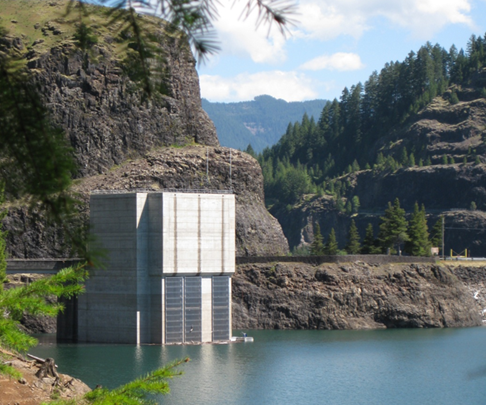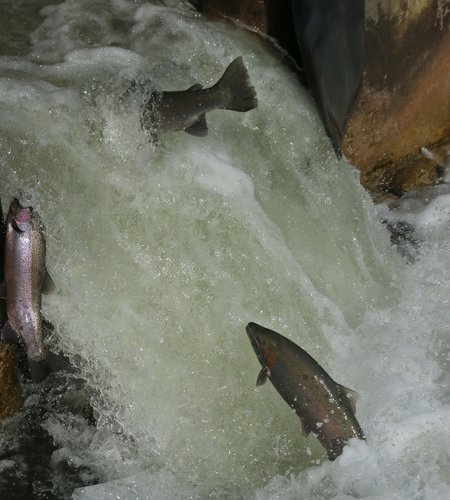Client
USGS Western Fisheries Research Center
Background
Fish passage at Cougar Dam near Springfield, Oregon was monitored using acoustics cameras.

Water temperature control tower at Cougar Reservoir, Oregon
Acoustic cameras (also known as imaging sonars or forward looking sonars) were used to measure fish presence, travel speed, and direction adjacent to a water temperature control tower in the forebay of Cougar Dam during the spring (May, June, and July) and fall (September, October, and November) of 2013. Cougar Dam is a high-head flood-control dam, and the water temperature control tower enables depth-specific water withdrawals to facilitate adjustment of water temperatures released downstream of the dam. The acoustic cameras were positioned at the upstream entrance of the tower to monitor free-ranging subyearling and yearling-size juvenile Chinook salmon (Oncorhynchus tshawytscha). Because of the large size discrepancy, we could distinguish juvenile Chinook salmon from their predators, which enabled us to measure predators and prey in areas adjacent to the entrance of the tower. We used linear models to quantify and assess operational and environmental factors—such as time of day, discharge, and water temperature—that may influence juvenile Chinook salmon movements within the beam of the acoustic cameras. Although extensive milling behavior of fish near the structure may have masked directed movement of fish and added unpredictability to fish movement models, the acoustic-camera technology enabled us to ascertain the general behavior of discrete size classes of fish. Fish travel speed, direction of travel, and counts of fish moving toward the water temperature control tower primarily were influenced by the amount of water being discharged through the dam.
Echoview was used to automate data processing procedures allowing more information collected on small fish to be used in the analysis. The Echoview platform allowed the operator to use successive filters to manipulate data in order to enhance the acoustic signal and remove static objects and noise from acoustic returns (Kang, 2011). Non stationary acoustic returns are then identified as targets within individual camera frames and converted to two dimensional position and time data, which can then be applied to target tracking.

Dataflow of semi-automated Echoview processing structure used to process acoustic camera targets at the water temperature control tower at Cougar Reservoir, Oregon
For more information
The full paper can be viewed here: https://pubs.er.usgs.gov/publication/ofr20151124
Acknowledgements
Echoview Software wishes to thank Collin D. Smith, Fishery Biologist, USGS Western Fisheries Research Center for permission to present this work.
Any use of trade, firm, or product names is for descriptive purposes only and does not imply endorsement by the U.S. Government.

